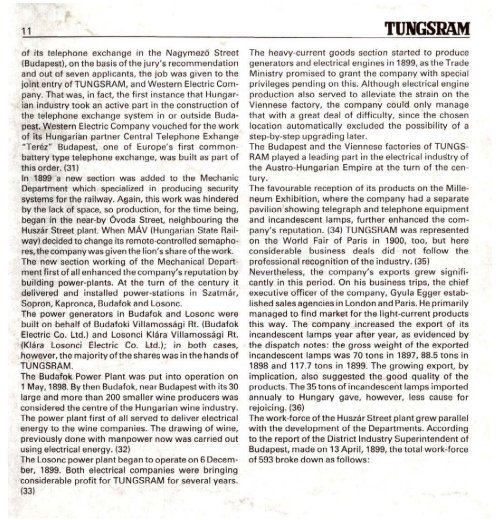THE HISTORY OF TUNGSRAM 1896-1945 - MEK
THE HISTORY OF TUNGSRAM 1896-1945 - MEK
THE HISTORY OF TUNGSRAM 1896-1945 - MEK
- No tags were found...
You also want an ePaper? Increase the reach of your titles
YUMPU automatically turns print PDFs into web optimized ePapers that Google loves.
11 <strong>TUNGSRAM</strong>of its telephone exchange in the Nagymezo Street(Budapest), on the basisof the jury's recommendationand out of seven applicants, the job was given to thejoint entry of <strong>TUNGSRAM</strong>, and Western Electric Company.That was, in fact, the first instance that Hungarianindustry took an active part in the construction ofthe telephone exchange system in or outside Budapest.Western Electric Company vouched for the workof its Hungarian partner Central Telephone Exhange"Terez" Budapest, one of Europe's first commonbatterytype telephone exchange, was built as part ofthis order. (31)In 1899 a new section was added to the MechanicDepartment which specialized in producing securitysystems for the railway. Again, this work was hinderedby the lack of space, so production, for the time being,began in the near-by 6voda Street, neighbouring theHuszar Street plant. When MAV (Hungarian State Railway)decided to change its remote-controlled semaphores,the company was given the lion's share of the work.The new section working of the Mechanical Departmentfirst of all enhanced the company's reputation bybuilding power-plants. At the turn of the century itdelivered and installed power-stations in Szatmar,Sopron, Kapronca, Budafok and Losonc.The power generators in Budafok and Losonc werebuilt on behalf of Budafoki Villamossagi Rt. (BudafokElectric Co. Ltd.) and Losonci Klara Villamossagi Rt.(Klara Losonci Electric Co. Ltd.); in both cases,however, the majority of the shares was in the hands of<strong>TUNGSRAM</strong>.The Budafok Power Plant was put into operation on1 May, 1898. By then Budafok, near Budapest with its 30large and more than 200 smaller wine producers wasconsidered the centre of the Hungarian wine industry.The power plant first of all served to deliver electricalenergy to the wine companies. The drawing of wine,previously done with manpower now was carried outusing electrical energy. (32)The Losonc power plant began to operate on 6 December,1899. Both electrical companies were bringingconsiderable profit for <strong>TUNGSRAM</strong> for several years.(33)The heavy-current goods section started to producegenerators and electrical engines in 1899, as the TradeMinistry promised to grant the company with specialprivileges pending on this. Although electrical engineproduction also served to alleviate the strain on theViennese factory, the company could only managethat with a great deal of difficulty, since the chosenlocation automatically excluded the possibility of astep-by-step upgrading later.The Budapest and the Viennese factories of TUNGSRAM played a leading part in the electrical industry ofthe Austro-Hungarian Empire at the turn of the century.The favourable reception of its products on the MilleneumExhibition, where the company had a separatepavilion showing telegraph and telephone equipmentand incandescent lamps, further enhanced the company'sreputation. (34) <strong>TUNGSRAM</strong> was representedon the World Fair of Paris in 1900, too, but hereconsiderable business deals did not follow theprofessional recognition of the industry. (35)Nevertheless, the company's exports grew significantlyin this period. On his business trips, the chiefexecutive officer of the company, Gyula Egger establishedsales agencies in London and Paris. He primarilymanaged to find market for the light-current productsthis way. The company increased the export of itsincandescent lamps year after year, as evidenced bythe dispatch notes: the gross weight of the exportedincandescent lamps was 70 tons in 1897, 88.5 tons in1898 and 117.7 tons in 1899. The growing export, byimplication, also suggested the good quality of theproducts. The 35 tons of incandescent lamps importedannualy to Hungary gave, however, less cause forrejoicing. (36) ^ .The work-force of the Huszar Street plant grew parallelwith the development of the Departments. Accordingto the report of the District Industry Superintendent ofBudapest, made on 13 April, 1899, the total work-forceof 593 broke down as follows:*/*"^'->








![Letöltés egy fájlban [4.3 MB - PDF]](https://img.yumpu.com/50159926/1/180x260/letaltacs-egy-fajlban-43-mb-pdf.jpg?quality=85)







